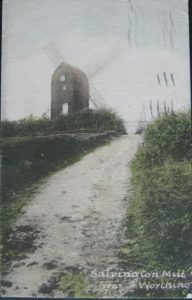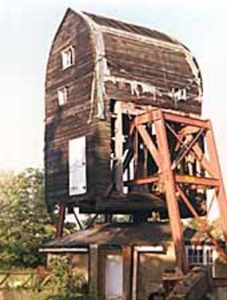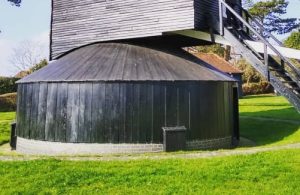Standing 320ft (98m) above sea level and commanding a fine view south over Worthing and the sea stands the black post mill at High Salvington. Adjacent to Mill Lane, an old roadway into Worthing, this last remaining mill to serve the Worthing area still stands defiantly against the elements. High Salvington Mill has a long history, probably being built about 1756, although the first map showing a mill on this site was printed in 1724. We know that a previous mill existed on this site in 1615 and we believe that the current mill replaced one that had burnt down in a fire.
the black post mill at High Salvington. Adjacent to Mill Lane, an old roadway into Worthing, this last remaining mill to serve the Worthing area still stands defiantly against the elements. High Salvington Mill has a long history, probably being built about 1756, although the first map showing a mill on this site was printed in 1724. We know that a previous mill existed on this site in 1615 and we believe that the current mill replaced one that had burnt down in a fire.
The oak post on which the mill rotates is 21ft 6in (6.6m) high. The foot of the post is actually several inches clear of the ground, the colossal weight of the mill being taken through the diagonal quarter-bars and onto the horizontal cross-trees of the trestle.
The mill worked for nearly 150 years until it was closed in 1897. In 1907/8 the old timber roundhouse was replaced with a concrete structure that was used as a tea room well into the 1950s.
 Worthing Borough Council purchased the mill for £2,250 in 1959. Edwin Hole, Millwrights, of Burgess Hill, undertook restoration work in the early 1960’s replacing a lot of the heavy timberwork in the main body of the mill.
Worthing Borough Council purchased the mill for £2,250 in 1959. Edwin Hole, Millwrights, of Burgess Hill, undertook restoration work in the early 1960’s replacing a lot of the heavy timberwork in the main body of the mill.
As a result of damage sustained during a gale in 1976 an inspection revealed that the mill was far from well. The High Salvington Mill Trust was inaugurated and a decision taken to completely restore the mill.
The hurricane of 1987 gave the mill its first taste of renewed life. The great wind turned the single pair of sails for the first time, although the brake was on!
The original style of roundhouse, known from old photographs, was reinstated in 1990 and the mill restarted grinding on 4th April 1991.
restarted grinding on 4th April 1991.